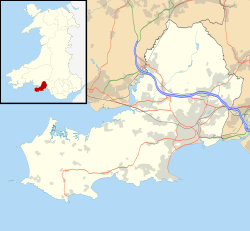St Andrew's Church, Penrice facts for kids
Quick facts for kids St Andrew's Church, Penrice |
|
|---|---|
| Church of St Andrew, Penrice | |

"a conservatively restored medieval church of interesting form"
|
|
| 51°34′12″N 4°10′33″W / 51.5701°N 4.1757°W | |
| Location | Penrice, Swansea |
| Country | Wales |
| Denomination | Church in Wales |
| History | |
| Status | Active |
| Founded | 12th century |
| Dedication | Saint Andrew |
| Architecture | |
| Heritage designation | Grade II* |
| Designated | 3 June 1964 |
| Architectural type | Church |
| Specifications | |
| Materials | Stone, slate roof |
The Church of St Andrew is a very old church located in Penrice, a community near Swansea, Wales. It was first built way back in the 12th century! This church is considered a special historic building, known as a Grade II* listed building. Even today, St Andrew's is still an active church, serving the people of South-West Gower in the Diocese of Swansea and Brecon.
Contents
History of St Andrew's Church
The Church of St Andrew is named after Saint Andrew. Its construction began in the early 1100s. Later in the 12th century, a powerful local family, the de Penrices, gave the church to the Knights Hospitaller. This was a famous group of knights who helped people during the medieval period. The de Penrice family had gained land in the Gower area during the Norman invasion of Wales.
Restoration and Continued Use
In the 1800s, the church needed some repairs and updates. A woman named Elizabeth Talbot, who lived at Penrice Castle, helped to restore it. Thanks to her efforts, the church was brought back to good condition. Today, St Andrew's Church continues to be an important part of the community. It is still an active parish church within the Diocese of Swansea and Brecon.
Design and Features of the Church
St Andrew's Church is quite large for a church in the Gower area. It is built using local stones, including red sandstone and limestone. The church has a special shape called "cruciform," which means it looks like a cross from above.
Key Parts of the Building
The church has several main parts:
- A tall tower
- The nave, which is the main area where people sit
- The chancel, located near the altar
- Two transepts, which are the "arms" of the cross shape
A famous architectural historian, John Newman, described the transepts as the church's "most remarkable feature." He noted how wide and deep they are. One of these transepts, the porch transept, was used for important church meetings in the Middle Ages. Later, it even became a schoolroom for local children!
Historic Status and Appearance
The church is a Grade II* listed building. This means it is a very important historical site. The official record describes it as "a conservatively restored medieval church of interesting form." This means it has been carefully repaired over the years, keeping its original medieval look.
Notable Grave in the Churchyard
In the churchyard, which is the area around the church, you can find the grave of Captain Sir Christopher Cole. He was a brave officer in the Royal Navy and was part of the Order of the Bath. He married into the Talbot family, who were important in the area. His grave marker is special because it is an early example of Celtic Revival art, created in 1836. It shows beautiful designs inspired by ancient Celtic art.


